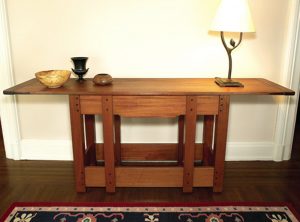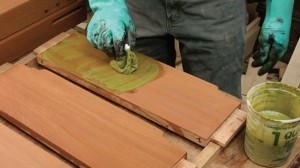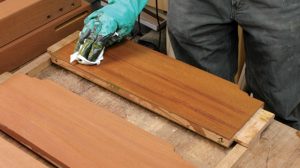We may receive a commission when you use our affiliate links. However, this does not impact our recommendations.
 I received an e-mail from a reader the other day, asking about finishes for Greene & Greene furniture. It’s one of those areas where we have some good clues about what was used, but we can’t be certain. There were some variations in color from house to house, as well as variations in wood. These pieces also lived in wealthy households, and it’s quite likely that they received a regular “polishing” of some sort, and over time that can affect what we see today.
I received an e-mail from a reader the other day, asking about finishes for Greene & Greene furniture. It’s one of those areas where we have some good clues about what was used, but we can’t be certain. There were some variations in color from house to house, as well as variations in wood. These pieces also lived in wealthy households, and it’s quite likely that they received a regular “polishing” of some sort, and over time that can affect what we see today.
Generally speaking, mahogany was used most often, and the finishes are nice, but not overly stained or filled. I wrote about this in my book “Shop Drawings for Greene & Greene Furniture” and in an article in the April 2005 issue of Popular Woodworking Magazine. If you want to see great photos of original pieces, pick up a copy of David Mathias’ book “Greene & Greene Furniture: Poems of Wood & Light.”
For the sideboard I built for the article, I used a finish recipe that I found online at the Greene & Greene Virtual Archives. The recipe was sent to the owner of the Thorsen house by Charles Greene, apparently so that some repairs or new work could be made to match work done when the house was originally built in 1908-1910. What follows is an excerpt from the April 2005 article.

The solution of potassium dichromate oxidizes the mahogany, turns it a rusty orange color and gives it an aged patina. After this treatment, a green stain made of artist’s oils and Danish oil is applied.
One of the most interesting discoveries I made on the Greene and Greene Virtual archives was a recipe for the finish for the furniture from another house. I have always admired the rich, vibrant color of the mahogany in original Greene and Greene furniture, something rarely seen in most reproductions of their work. The formula called for a treatment of potassium dichromate applied “as work proceeds” followed by a “filler” composed of four colors mixed in linseed oil.
Potassium dichromate is a powerful oxidizer and must be handled carefully. I wore a respirator while mixing it and gloves while applying it. After experimenting, I used a solution of 3/8 ounce of powder to a quart of distilled water. For the colors, I used artist’s oil colors. Chrome Yellow (3-1/2 parts of the formula) and Raw Umber (3 parts) were easy selections. White Lead (2-5/8 parts) is no longer made, so I used Titanium White. The last color listed was Sylvan Green (1/8 part), and I couldn’t find an oil color with this name. Because it was a small part of the original mixture, I took a guess and used Hooker’s Green.

After wiping off the excess, the mahogany is left a rich, reddish brown color. This is the same technique used in original Greene and Greene furniture. After the stain dried, three additional coats of oil were applied.
I squeezed out the colors in the proportions given on a scrap of plywood and mixed them together with a pint of Danish oil. Following a recipe, I hadn’t thought about what color would be the result. I was expecting a rich, reddish brown and was surprised to see a shade of green I haven’t seen since my son has been out of diapers. I was ready to abandon the experiment because of the horrendous color I had mixed, but curiosity won and I tried it on my sample board. After wiping off the excess, I was pleased to find a truly wonderful color and sheen on the mahogany, as shown above. What first appeared as a mistake makes sense technically. On a color wheel, the red from the chemical treatment and the green from the stain are opposite each other, producing a perfect color.
Before I did any assembly work, I brushed on the potassium dichromate solution and wiped each part dry. Letting the parts dry overnight, I applied the stain I had mixed, waited about five minutes and wiped off the excess. Doing all of the color work before assembly let me get an even coat on all the surfaces of all the parts. This saved me from reaching in and around the legs and rails on the assembled table base. I gave the entire table three additional coats of Danish oil after it was assembled.
I wasn’t terribly clear in the article what I used as a “part”, and clarified that in this response to a reader in the August 2005 issue:
I squeezed out a line of the artist’s oil color on a piece of scrap wood, using 1″ as one part. I had a line of Chrome Yellow 3-1/2″ long, the line of Raw Umber was 3″ long, etc. That’s how I kept the proportions straight. To get the color strong enough, I had to double the amounts above. If I were doing it over, I would mark out the proportions on the scrap, and then squeeze out two lines for each color. Also note that the green color I added was just a dab. I don’t think you need to be incredibly precise with it, but this should get you close.
Charles Greene’s handwritten recipe and notes are available online at the Greene & Greene Virtual Archives. Follow this link for Charles Greene’s finish recipe and this link to Charles Greene’s note to William Thorsen about the finish.
Here are some supplies and tools we find essential in our everyday work around the shop. We may receive a commission from sales referred by our links; however, we have carefully selected these products for their usefulness and quality.










As someone with a degree in Chemistry, I also have my concerns about using a dichromate salt. Potassium Permanganate is another compound which is also a strong oxidizer, but should be much less toxic and easier to dispose of (don’t quote me on that). Unless the reduced chromium ion affects the color, I don’t see why another oxidizing agent (there are several strong ones, and some weak ones as well) couldn’t be used. Has anyone experimented with this? I’d do it myself but I don’t have access to Mahogany to test and compare it.
Thanks for the tips. also make sure you listen to what Steve_OH said about disposing of the potassium dichromate.
I agree with the hazards of PD . The thing is , what dye or stain can be used to get that very colour that was produced by the PD treatment.I have tried all we have here (South Africa) but with no luck. I might be moving to TX soon, so i would like to know what can be used to get to that colour. Would appreciate if someone can help.
Since it is water based I was wondering if it raised the grain after you put the potassium dichromate on the mahogany, and if you did any sanding before you applied the stain? Thanks.
Jim
At my former job we used a product called chromic acid for cleaning some of the machinery. From what little I know about it I’m pretty sure it’s very similar to potassium dichromate. I probably would be hesitant to use it in a home shop( at least if it were an attached shop and not an out building) I remember that it caused a pretty bad rash if it came into contact with skin. Luckily I very rarely had to come into contact with it. That being said the finish it leaves does look amazing.
miserybob says:
Don’t use this, folks.
I’m very surprised PW has this on their site… seems like a dandy opportunity for a lawsuit.
It’s disappointing and irresponsible.
Spoken like a personal injury lawyer. Maybe you should put the coffe cup down, step off of your chair, and just take a few deep breaths. You must have missed where Bob mentioned it was a powerful oxidizer, and must be used carefully, respirator, and gloves used when mixing and handling. You know your own habits, so if you frequently splash chemicals you are working with in your eyes, I would suggest eyewear to protect you from yourself. The MSDS goes into oral obsorption, I would think anyone would forego this as a snack food. As with any substance on earth the MSDS for it is used primarily as an industrial tool for folks with long work related exposures to chemicals. Time of exposure, amount of exposure (dose related), and a multitude of other things are taken into consideration when figuring a chemicals toxicity. For a woodworker who is just going to be around this product for a very short period of time, your arm waving histronics are not warranted, if the user, just uses a bit of common sense, and dons appropriate protective garb. If you want to go all willy nilly, I suggest you start looking at every product you touch in your woodworking finishes, as a good many of them have what may at first appear to be very disturbing MSDS information. I`d also suggest when looking for valid information to NOT look at the wiki for info being correct, go to a site with credibility. For chemicals I would suggest MSDS, and though MSDS may be added on a wiki post, the nature of wiki is that information can be modified, changed, or falsified.
Also suggested is to let the product dry, and then dispose of it where it cannot enter the water system. I would hope that logic is used on all finishing products, garden chemicals, and cleaners from your household.
As Steve says…
From the MSDS:
“May cause allergy or asthma symptoms or breathing difficulties if inhaled. May cause genetic defects. May cause cancer. May damage fertility or the unborn child.
Causes damage to organs through prolonged or repeated exposure if inhaled. Very toxic to aquatic life.
Obtain special instructions before use. Keep/Store away from clothing/ combustible materials. Do not breathe dust/ fume/ gas/ mist/ vapours/ spray. Wash hands thoroughly after handling. Avoid release to the environment. Wear protective gloves/ protective clothing/ eye protection/ face protection. Wear respiratory protection. IF ON SKIN: Gently wash with plenty of soap and water. IF IN EYES: Rinse cautiously with water for several minutes. Remove contact lenses, if present and easy to do. Continue rinsing. Immediately call a POISON CENTER or doctor/ physician.
May be fatal if inhaled. Material is extremely destructive to the tissue of the mucous membranes and upper respiratory tract. May be fatal if absorbed through skin. Causes skin burns. Causes eye burns.
May be fatal if swallowed.”
Don’t use this, folks.
I’m very surprised PW has this on their site… seems like a dandy opportunity for a lawsuit.
It’s disappointing and irresponsible.
Potassium dichromate is more than just a powerful oxidizer. I would advise anyone considering using it to take a look at the Wikipedia article: http://en.wikipedia.org/wiki/Potassium_dichromate#Safety.
Whatever you do, don’t rinse the excess down the drain. Mix it up in a disposable container, let the leftovers dry out, then, if you don’t have any local hazardous waste facility, put it in the regular trash so that it goes to a landfill instead of ending up in the water supply.
-Steve